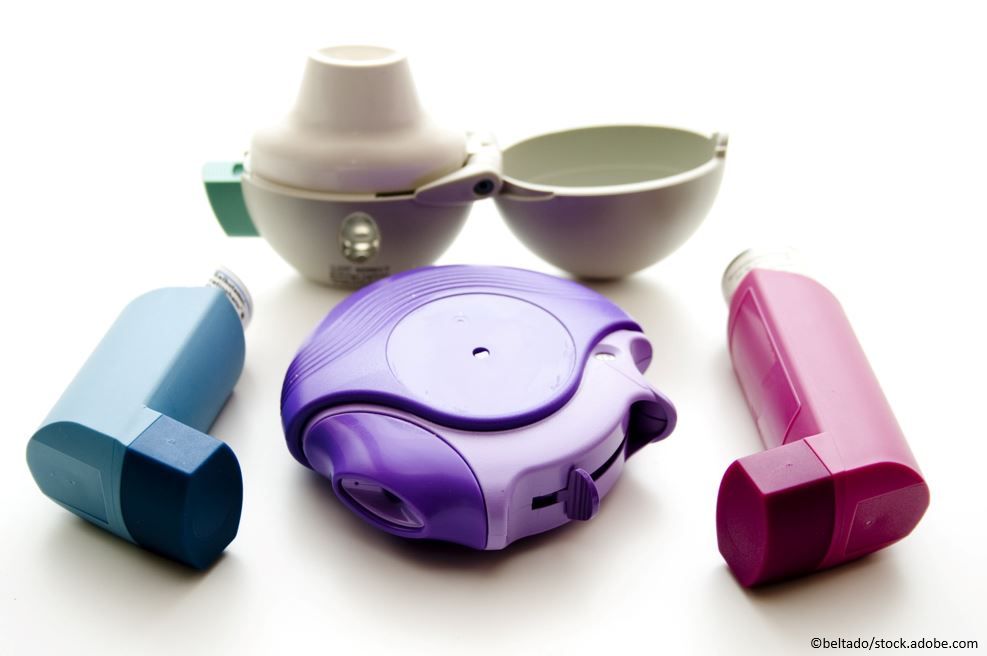- Clinical Technology
- Adult Immunization
- Hepatology
- Pediatric Immunization
- Screening
- Psychiatry
- Allergy
- Women's Health
- Cardiology
- Pediatrics
- Dermatology
- Endocrinology
- Pain Management
- Gastroenterology
- Infectious Disease
- Obesity Medicine
- Rheumatology
- Nephrology
- Neurology
- Pulmonology
Novel Fixed-dose Albuterol-Budesonide Inhaler Significantly Reduced Exacerbation Risk in Severe Asthma
ATS 2022: A fixed dose SABA/corticosteroid combination reduced risk of exacerbation by 27% vs SABA alone in the MANDALA study.

A novel fixed dose combination of albuterol and budesonide used as needed by patients with uncontrolled moderate to severe asthma more effectively reduced the risk of a severe disease exacerbation when compared with albuterol alone.
Specifically, the short-acting beta2-agonist (SABA) and corticosteroid combination (PT027, AstraZeneca) when used as rescue medication significantly reduced the risk of severe asthma exacerbation by 27% when compared with albuterol monotherapy.
The data, from the MANDALA phase 3 clinical trial, were simultaneously published in the New England Journal of Medicine and presented at the American Thoracic Society 2022 International Conference, held in San Francisco. May 13-18, 2022.
SABA, the traditional rescue therapy for worsening asthma symptoms, do not address airway inflammation, a central feature of asthma and exacerbations, write study authors, led by Alberto Papi, MD, professor of respiratory medicine and director of respiratory diseases at the University of Ferrara, Italy. The inflammatory cascade, left unchecked, leaves patients at risk for a severe disease episode, for more frequent exacerbations, hospitalization, and frequent use of oral corticosteroids (OCS). The latter, the authors emphasize, with as few as 1-2 short courses, are associated with a wide range of adverse health conditions.
The MANDALA authors hypothesize that the addition of a corticosteroid to SABA rescue treatment could reduce the risk of severe exacerbations and so also the need for OCS.
MANDALA design
MANDALA was a multinational phase 3 randomized controlled event-driven trial designed to investigate the efficacy and safety of albuterol-budesonide compared with albuterol alone as rescue medication in patients with uncontrolled, moderate to severe asthma.
Papi and colleagues enrolled adults and adolescents (aged ≥12 years) and children (aged 4–11 years) with symptomatic asthma and at least 1 severe exacerbation in the past year.
Randomization was completed in a 1:1:1 fashion to one of 3 treatment groups: a fixed-dose combination of 180 μg of albuterol and 160 μg of budesonide (the higher dose combination group), a fixed-dose combination of 180 μg of albuterol and 80 μg of budesonide (the lower-dose combination group), or 180 μg of albuterol (the albuterol-alone group). All participants were receiving inhaled glucocorticoid-containing maintenance therapies with or without additional controller medications and remained on them throughout the trial.
Children aged 4 to 11 years, investigators note, were randomly assigned to either the lower-dose combination group or the albuterol-only group.
Based on a time-to-event analysis, the primary efficacy endpoint was the first experience of a severe asthma exacerbation in the intention-to-treat population.
Exacerbation risk significantly reduced
The final randomized cohort numbered 3132 patients with 97% aged ≥12 years (183 aged 4 to <18 years). Mean age was approximately 49 years, two-thirds were women, and the majority were White.
Papi et al found, in a preplanned efficacy analysis, the primary endpoint of time to first severe asthma exacerbation was significantly lower, by 27%, among patients treated with the higher-dose fixed-dose combination of albuterol 180 µg/budesonide 160 µg compared with those who received albuterol 180 µg alone (hazard ratio [HR] = 0.73; 95% confidence interval [CI], 0.61-0.88; P<.001) and 17% lower in those who received the lower-dose combination of albuterol 180 µg/budesonide 80 µg (HR = 0.83; 95% CI, 0.7-0.99; P=.041).
When they analyzed the intention-to-treat group, the investigators found that risk was reduced by 26% with the higher-dose combination (HR = 0.74; 95% CI, 0.62-0.89; P .001) and by 16% with the lower-dose combination (HR = 0.84; 95% CI, 0.71-1; P=.052).
Adverse events, according to the published study, were consistent with the known safety profiles of the individual components; the most common adverse events were nasopharyngitis, headache and upper respiratory tract infection.
“The MANDALA Phase III trial results demonstrated that PT027, a novel fixed-dose combination of albuterol/budesonide used as-needed, provided additional anti-inflammatory treatment in response to patient symptoms, which led to a reduced risk of severe exacerbations compared with albuterol alone,” said coauthor Bradley E Chipps, MD.
“These data further strengthen the growing body of evidence around the value of as-needed anti-inflammatory treatment in asthma and support PT027’s potential to transform the current rescue treatment approach,” concluded Chipps, who is also past president of the American College of Allergy, Asthma & Immunology and is medical director of Capital Allergy & Respiratory Disease Center in Sacramento, CA. His statement was made in a press release from AstraZeneca.
Reference: Papi A, Chipps BE, Beasley R, et al. Albuterol–budesonide fixed-cose combination rescue inhaler for asthma. NEJM. Published online ahead of print May 15, 2022. DOI: 10.1056/NEJMoa2203163
